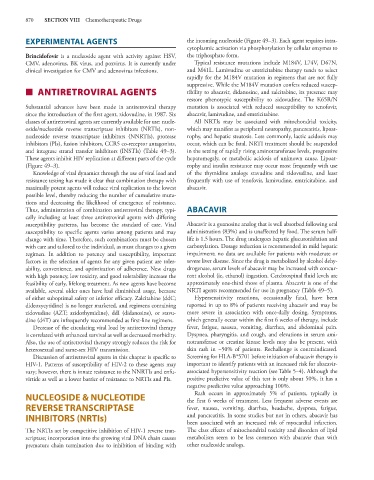Page 884 - Basic _ Clinical Pharmacology ( PDFDrive )
P. 884
870 SECTION VIII Chemotherapeutic Drugs
EXPERIMENTAL AGENTS the incoming nucleotide (Figure 49–3). Each agent requires intra-
cytoplasmic activation via phosphorylation by cellular enzymes to
Brincidofovir is a nucleoside agent with activity against HSV, the triphosphate form.
CMV, adenovirus, BK virus, and poxvirus. It is currently under Typical resistance mutations include M184V, L74V, D67N,
clinical investigation for CMV and adenovirus infections. and M41L. Lamivudine or emtricitabine therapy tends to select
rapidly for the M184V mutation in regimens that are not fully
suppressive. While the M184V mutation confers reduced suscep-
■ ANTIRETROVIRAL AGENTS tibility to abacavir, didanosine, and zalcitabine, its presence may
restore phenotypic susceptibility to zidovudine. The K65R/N
Substantial advances have been made in antiretroviral therapy mutation is associated with reduced susceptibility to tenofovir,
since the introduction of the first agent, zidovudine, in 1987. Six abacavir, lamivudine, and emtricitabine.
classes of antiretroviral agents are currently available for use: nucle- All NRTIs may be associated with mitochondrial toxicity,
oside/nucleotide reverse transcriptase inhibitors (NRTIs), non- which may manifest as peripheral neuropathy, pancreatitis, lipoat-
nucleoside reverse transcriptase inhibitors (NNRTIs), protease rophy, and hepatic steatosis. Less commonly, lactic acidosis may
inhibitors (PIs), fusion inhibitors, CCR5 co-receptor antagonists, occur, which can be fatal. NRTI treatment should be suspended
and integrase strand transfer inhibitors (INSTIs) (Table 49–3). in the setting of rapidly rising aminotransferase levels, progressive
These agents inhibit HIV replication at different parts of the cycle hepatomegaly, or metabolic acidosis of unknown cause. Lipoat-
(Figure 49–3). rophy and insulin resistance may occur most frequently with use
Knowledge of viral dynamics through the use of viral load and of the thymidine analogs stavudine and zidovudine, and least
resistance testing has made it clear that combination therapy with frequently with use of tenofovir, lamivudine, emtricitabine, and
maximally potent agents will reduce viral replication to the lowest abacavir.
possible level, thereby reducing the number of cumulative muta-
tions and decreasing the likelihood of emergence of resistance.
Thus, administration of combination antiretroviral therapy, typi- ABACAVIR
cally including at least three antiretroviral agents with differing
susceptibility patterns, has become the standard of care. Viral Abacavir is a guanosine analog that is well absorbed following oral
susceptibility to specific agents varies among patients and may administration (83%) and is unaffected by food. The serum half-
change with time. Therefore, such combinations must be chosen life is 1.5 hours. The drug undergoes hepatic glucuronidation and
with care and tailored to the individual, as must changes to a given carboxylation. Dosage reduction is recommended in mild hepatic
regimen. In addition to potency and susceptibility, important impairment; no data are available for patients with moderate or
factors in the selection of agents for any given patient are toler- severe liver disease. Since the drug is metabolized by alcohol dehy-
ability, convenience, and optimization of adherence. New drugs drogenase, serum levels of abacavir may be increased with concur-
with high potency, low toxicity, and good tolerability increase the rent alcohol (ie, ethanol) ingestion. Cerebrospinal fluid levels are
feasibility of early, lifelong treatment. As new agents have become approximately one-third those of plasma. Abacavir is one of the
available, several older ones have had diminished usage, because NRTI agents recommended for use in pregnancy (Table 49–5).
of either suboptimal safety or inferior efficacy. Zalcitabine (ddC; Hypersensitivity reactions, occasionally fatal, have been
dideoxycytidine) is no longer marketed, and regimens containing reported in up to 8% of patients receiving abacavir and may be
zidovudine (AZT; azidothymidine), ddI (didanosine), or stavu- more severe in association with once-daily dosing. Symptoms,
dine (d4T) are infrequently recommended as first-line regimens. which generally occur within the first 6 weeks of therapy, include
Decrease of the circulating viral load by antiretroviral therapy fever, fatigue, nausea, vomiting, diarrhea, and abdominal pain.
is correlated with enhanced survival as well as decreased morbidity. Dyspnea, pharyngitis, and cough, and elevations in serum ami-
Also, the use of antiretroviral therapy strongly reduces the risk for notransferase or creatine kinase levels may also be present, with
heterosexual and same-sex HIV transmission. skin rash in ~50% of patients. Rechallenge is contraindicated.
Discussion of antiretroviral agents in this chapter is specific to Screening for HLA-B*5701 before initiation of abacavir therapy is
HIV-1. Patterns of susceptibility of HIV-2 to these agents may important to identify patients with an increased risk for abacavir-
vary; however, there is innate resistance to the NNRTIs and enfu- associated hypersensitivity reaction (see Table 5–4). Although the
virtide as well as a lower barrier of resistance to NRTIs and PIs. positive predictive value of this test is only about 50%, it has a
negative predictive value approaching 100%.
Rash occurs in approximately 5% of patients, typically in
NUCLEOSIDE & NUCLEOTIDE the first 6 weeks of treatment. Less frequent adverse events are
REVERSE TRANSCRIPTASE fever, nausea, vomiting, diarrhea, headache, dyspnea, fatigue,
INHIBITORS (NRTIs) and pancreatitis. In some studies but not in others, abacavir has
been associated with an increased risk of myocardial infarction.
The NRTIs act by competitive inhibition of HIV-1 reverse tran- The class effects of mitochondrial toxicity and disorders of lipid
scriptase; incorporation into the growing viral DNA chain causes metabolism seem to be less common with abacavir than with
premature chain termination due to inhibition of binding with other nucleoside analogs.

